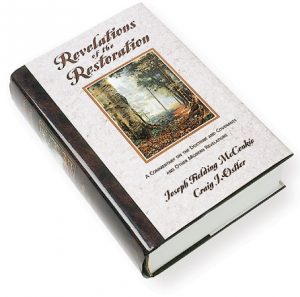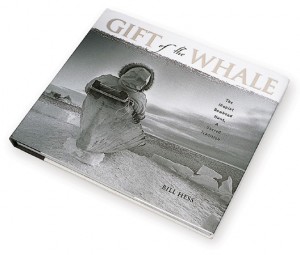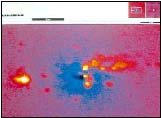By Richard H. Cracroft
Whether you are a bibliophile (one who loves books), a bibliosopher (one who gains wisdom from books), a bibliomane (one who accumulates books indiscriminately), a bibliobibule (one who reads too much), a (heaven forbid) bibliolater (one who worships books), or, like me, a humble bibliograph (one who describes books), you’ll find something somewhere in this issue’s picks to support you in your bibliomania. Here goes.
In Near Cumorah’s Hill: Images of the Restoration (American Fork, Utah: Covenant Communications, 2000; 120 pp.; $29.95), Paul E. Gilbert, ’83, and Douglas L. Powell, ’88, have combined stunning photography and compelling history into a wonderfully rewarding volume that enlivens the places, nooks, and landscapes associated with major events and people of the Restoration. Time and space dissolve in the happy mix of Gilbert’s photography and Powell’s historical glimpses, and for a few treasured moments we see and sense how it was in those momentous days. The Encyclopedia of Latter-day Saint History (Salt Lake City: Deseret Book, 2000; 1,454 pp.; $49.95), crisply edited by BYU professors Arnold K. Garr, ’86, Donald Q. Cannon, and Richard O. Cowan, ’56, is a superb one-volume historical resource with more than 1,400 entries about every aspect of Church history–enough to satisfy even the most jaded bibliobibule. Another useful reference work is Revelations of the Restoration: A Commentary on the Doctrine and Covenants and Other Modern Revelations (Salt Lake City: Deseret Book, 2000; 1,197 pp.; $49.95), by BYU religion professor Joseph Fielding McConkie, ’65, and assistant professor Craig J. Ostler, ’77. This is the most comprehensive single-volume resource on the Doctrine and Covenants to date and a timely companion to the 2001 Sunday School lessons. McConkie and Ostler carefully place each of the modern revelations in its historical and doctrinal contexts and provide useful commentary.
The Encyclopedia of Latter-day Saint History (Salt Lake City: Deseret Book, 2000; 1,454 pp.; $49.95), crisply edited by BYU professors Arnold K. Garr, ’86, Donald Q. Cannon, and Richard O. Cowan, ’56, is a superb one-volume historical resource with more than 1,400 entries about every aspect of Church history–enough to satisfy even the most jaded bibliobibule. Another useful reference work is Revelations of the Restoration: A Commentary on the Doctrine and Covenants and Other Modern Revelations (Salt Lake City: Deseret Book, 2000; 1,197 pp.; $49.95), by BYU religion professor Joseph Fielding McConkie, ’65, and assistant professor Craig J. Ostler, ’77. This is the most comprehensive single-volume resource on the Doctrine and Covenants to date and a timely companion to the 2001 Sunday School lessons. McConkie and Ostler carefully place each of the modern revelations in its historical and doctrinal contexts and provide useful commentary.
On a different note, Printing in Deseret: Mormons, Economy, Politics, & Utah’s Incunabula, 1849–1851 (Salt Lake City: University of Utah Press, 2000; 213 pp.; $35), by Richard L. Saunders, ’92, is a brief but well-packed study of the beginnings of printing in the Salt Lake Valley in 1849, when Mormon leaders used the press to publish now-forgotten documents intended to promote cohesiveness and communication among the reassembling Latter-day Saints, foster regional economics in the context of the California gold rush, and promote national political recognition. Saunders is the curator of special collections and archives at the Paul Meek Library of the University of Tennessee at Martin.
Building on the fundamental teaching that the gospel of Jesus Christ has been on earth “from the beginning” (Moses 5:58; see also D&C 20), Matthew B. Brown, ’98, establishes in All Things Restored: Confirming the Authenticity of LDS Beliefs (American Fork, Utah: Covenant Communications, 2000; 274 pp.; $27.95) the facts of the great apostasy and then meticulously and convincingly traces, in eight well-researched chapters, the restoration of all things in the last dispensation. Brown points out significant parallels between the teachings of the ancient church and The Church of Jesus Christ of Latter-day Saints. In Three Degrees of Glory: Joseph Smith’s Insights on the Kingdoms of Heaven (American Fork, Utah: Covenant Communications, 2000; 66 pp.; $7.95), Lawrence R. Flake, ’65, BYU professor of church history and doctrine, makes available the too-little known narrative poem, “A Vision,” a poetic rendering of Doctrine and Covenants 76. The poem, published in the Times and Seasons in February 1843 and purportedly written by the Prophet Joseph Smith (probably in collaboration with poet and hymn-writer W.W. Phelps), is presented here side by side with D&C 76, for ready textual comparison. Also of interest to students of the Prophet Joseph Smith is the republication of Lucy Mack Smith’s The History of Joseph Smith, by His Mother, as revised by George A. Smith and Elias Smith (American Fork, Utah: Covenant Communications, 2000; 322 pp.; $14.95).
Four books by BYU alumni have recently found publication and readers in the national market. The heart-warming personal account of Kenny Kemp, ’80, Dad Was a Carpenter: Blueprints for a Meaningful Life (Salt Lake City: Alta Films Press, 1999; 160 pp.; $13.95), has been purchased by HarperSanFrancisco, the inspirational/religious imprint of HarperCollins. Another distinguished BYU alum, Orin D. Parker, ’48, after a career mostly in the Middle East, has published a novel of international political intrigue, Burial in Beirut (San Jose, Calif.: Writer’s Showcase Press, 2000; 332 pp.; $15.95; available for downloading at www.iuniverse.com). Rich, an American law student visiting family in Beirut, falls in love with a beautiful and militant Palestinian activist, becomes entangled in her commitment to  terrorism, and embroils his father in the Palestinian resistance. Another exciting read, in a very different way, is a new edition of Gary B., ’57, and Joy S. Lundberg’s I Don’t Have to Make Everything All Better (New York: Penguin, 2000; 302 pp.; $12.95). The popular and very readable self-help guide (with a workbook in this edition) helps readers find “greater fulfillment, peace, and joy” in human relationships. Bill E. Hess, ’73, (one of my students in the early 1970s) has written a very special book in Gift of the Whale: The Iñupiat Bowhead Hunt, A Sacred Tradition (Seattle: Sasquatch Books, 1999; 227 pp.; $40). Hess, an award-winning photographer and writer whose work has appeared in National Geographic, GEO, and Field and Stream, has developed close ties with the Alaskan Native community over many years. In Gift of the Whale he takes us, in telling prose and stark duotone photographs shot over a number of years, on the annual bowhead hunt of the Iñupiat Eskimos. He takes us into a cold and inhospitable climate and among this warm and open-handed people to chronicle their annual whale hunt, a unifying and centering tradition that not only physically feeds them but nourishes them culturally and spiritually as well. This is a fascinating book.
terrorism, and embroils his father in the Palestinian resistance. Another exciting read, in a very different way, is a new edition of Gary B., ’57, and Joy S. Lundberg’s I Don’t Have to Make Everything All Better (New York: Penguin, 2000; 302 pp.; $12.95). The popular and very readable self-help guide (with a workbook in this edition) helps readers find “greater fulfillment, peace, and joy” in human relationships. Bill E. Hess, ’73, (one of my students in the early 1970s) has written a very special book in Gift of the Whale: The Iñupiat Bowhead Hunt, A Sacred Tradition (Seattle: Sasquatch Books, 1999; 227 pp.; $40). Hess, an award-winning photographer and writer whose work has appeared in National Geographic, GEO, and Field and Stream, has developed close ties with the Alaskan Native community over many years. In Gift of the Whale he takes us, in telling prose and stark duotone photographs shot over a number of years, on the annual bowhead hunt of the Iñupiat Eskimos. He takes us into a cold and inhospitable climate and among this warm and open-handed people to chronicle their annual whale hunt, a unifying and centering tradition that not only physically feeds them but nourishes them culturally and spiritually as well. This is a fascinating book.
Finally, I recommend a moving and memorable first novel–Dory J.
Peters’ Winds of Change (Springville, Utah: Cedar Fort, 2000; 143 pp.; $11.95). In this engaging, insightful, and culture-bridging novel, Dory J. Peters becomes the first NavajoLDS returned missionary to tell, in first-rate fiction, how it is to grow up in both Navajo and LDS families; how it is to be torn from a cherished, familiar, organic, inward, image-centered, and deeply traditional way of viewing the world and thrust into a vastly different, mechanistic, word-centered society, every bit as deep and traditional; how it is to become and remain part of both Navajo clan and Mormon family; and how he struggles to identify and cultivate the best of each, while remaining an Other in both cultures. Peters’ story, grounded in his own experience but recounted by the fictional persona of Victor, a returned missionary visiting his reservation home on business, is poignant, powerful, enlightening, and well told–a triumphant fictional first in Mormon literature, an important book which gently but movingly teaches racial and cultural toleration, inclusion, and understanding. Every Latter-day Saint will enjoy this novel.
Until next time, have a good read–and be sure not to biblioriptos-ize (throw books around) or to bibliotaphe-ize (bury or hide books)!
Richard H. Cracroft is the Nan Osmond Grass Professor in English; he is also director of the Center for the Study of Christian Values in Literature at BYU, where he has taught since 1963. He currently serves as bishop of the BYU 203rd Ward.









